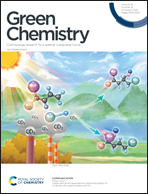Development of a Ni-promoted, selective electrochemical reductive cleavage of the C–O bond in lignin model compound benzyl phenyl ether†
Abstract
Current catalytic hydrogenolysis of lignin C–O bonds, which is crucial for lignin valorization, often requires a noble metal catalyst or/and harsh conditions such as elevated temperatures and high pressures. Herein, we report a highly selective electrochemical protocol to reductively cleave the benzylic C–O bond of the α-O-4 lignin model compound benzyl phenyl ether (BPE) at room temperature and ambient pressure. Nearly complete conversion of BPE to toluene and phenol in methanol was achieved in an undivided cell using Ni foam at both the anode and cathode, with yields of 97% and 30%, respectively. Using a divided cell, yields of 90% (toluene) and 84% (phenol) could be achieved using inexpensive carbon paper as the cathode when Ni(II) salts were added to the cathode chamber. Notably, other divalent metal salts did not lead to any product formation, suggesting a unique role of Ni ions in benzylic C–O bond cleavage. Further, a substrate scope study revealed the suitability of the method for a variety of substituted BPEs. This work provides an economical and environmentally friendly method for selective cleavage of C–O bonds in benzylic ethers as model compounds for lignin.



 Please wait while we load your content...
Please wait while we load your content...